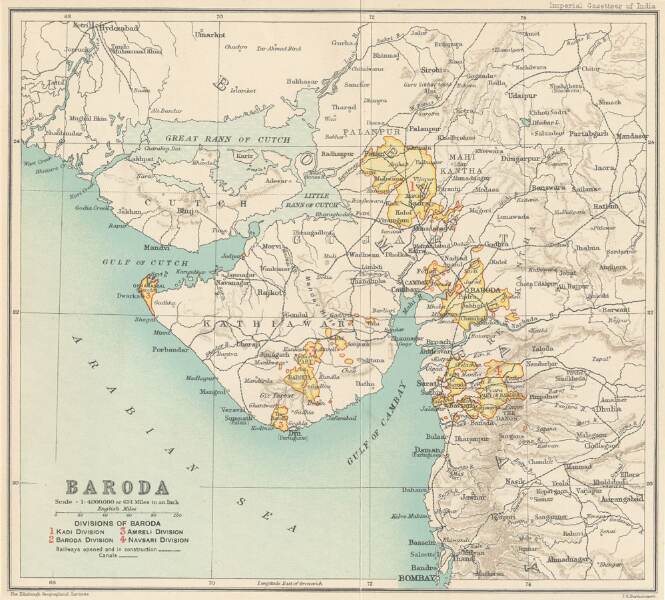Tragedy of Baroda
Maharaja Pratap Singh failed utterly to provide leadership towards integration of smaller Gujarat states into the Union — a gap that necessitated their merger with Bombay

Of the five 21-gun salute states, three, viz J&K, Mysore and Hyderabad retained their individual identity. Gwalior was merged along with Indore and other smaller states into Madhya Bharat but the Scindia ruler of Gwalior became the raj pramukh of the new state with Gwalior as the capital city. Baroda, on the other hand, lost every opportunity that was offered to it to lead the integration of Gujarat states on the pattern of Patiala and East Punjab States Union (PEPSU). In fact, as Menon wrote in his book, 'no ruler in India succeeded to a richer heritage than Major General, Farzand-i-Khas-i-Daulat-i-Inglishia, Sir Pratap Singh Gaekwar, Sena Khas Khel, Samsher Bahadur, Maharaja of Baroda'. Despite having inherited resources, goodwill and reserves, he squandered his invaluable heritage and in less than two years, Baroda lost her identity as an independent entity.
In fact, when the ruler of Junagadh announced the arbitrary and unwise merger of Junagadh with Pakistan, and left the country, it was expected that as the proximate premier princely state with an effective Army, Pratap Singh would naturally come to the assistance of his mother country. He, however, adopted a 'supercilious' attitude by writing to the Sardar that he should first be recognized as the King of Saurashtra and Gujarat as a precondition. He was promptly snubbed, and told that his help was not required. This was the beginning of the end of dominance of the state, but more than that, of its ruler who lost the support of practically everyone by this action.
However, from the point of view of the integration of states, it became clear that Baroda would not be able to provide leadership to the Gujarat states in the matter of forming a Union, and its ruler certainly lost his credibility for the position of a rajpramukh. The Gujarat states were, in the first instance, inclined to form a Union under the leadership of Baroda, but on account of the lack of foresight of Maharaja Pratap Singh, who was whimsical and unpopular, the opportunity was missed. Moreover, he was at odds with the popular ministry under Jivraj Mehta, and was even accused of overdrawing his authorised allowance, besides diverting state resources for his personal use. He was also accused of transferring some of the Crown jewels to England without any authorisation or record.
Before leaving for England in May 1948, he wrote off a loan of Rs 220 lakh to himself, and also drew another Rs 105 lakh from the Treasury for the future marriage expenses of his daughters. Mehta called a special meeting of the Baroda Legislative Assembly, that now questioned 'his fitness to rule', asked him to abdicate in favour of his son, and also sought a special audit of the finances of the state, for which a senior officer of the Indian Audits and Accounts service was deputed . Several serious anomalies, including the misappropriation of Rs six crore and unauthorised withdrawal of state jewels, including the diamond necklace with the priceless stones — Star of South, Eugene and Shahee Akbar — which had been sent to England, were reported. The States Ministry now came to the conclusion that it was not possible for Baroda to retain its 'independence' and that it had to be merged with Bombay.
With Baroda's failure to provide leadership to 17 jurisdictional and 127 semi and non-jurisdictional sates, it was clear that there was no option for the states but to merge with Bombay. None of these states were large enough, and their territories were interspersed and interlocked with Baroda, as well as the Ahmedabad and Kaira districts of Bombay. Although they covered an extensive area of nearly 12,000 square miles, the population was just over 21 lakh and the annual revenue was less than a crore and a half. Most of the rulers of the jurisdictional states were Rajputs belonging to the Solanki, Chauhan, Waghela, Sisodia, Parmar and Gohel clans. States under Muslim rulers included Balasinor, Cambay, Sachin and Radhanpur.
The first informal meeting between the States Ministry, represented by VP Menon and the rulers of Gujarat, was held at the Bombay residence of the Maharaja of Rajpipla in March 1948. Rajpipla of the Gohel Rajput dynasty, which lay between Narmada and Tapti, was second in size, resources and population only to Baroda, and he worked closely with the States Ministry to ensure that the rulers were granted their privileges and privy purses on the pattern of the eastern States. All these states were merged into the state of Bombay by May 1948.
On his part, the Maharaja of Baroda took yet another unwise decision of taking the leadership of an informal Rulers Union in Bombay in January 1951 and started touring states under the pretext of shikar, but only to foment unrest amongst the formal royals. He received support from the likes of Jodhpur and other disgruntled elements. This had to be nipped in the bud, and within April of the same year, a presidential proclamation was issued under Article 366 (2) 'derecognizing' him as the Ruler of Baroda, and the mantle was passed on to his son Yuvraj Fateh Singh.
Views expressed are personal




